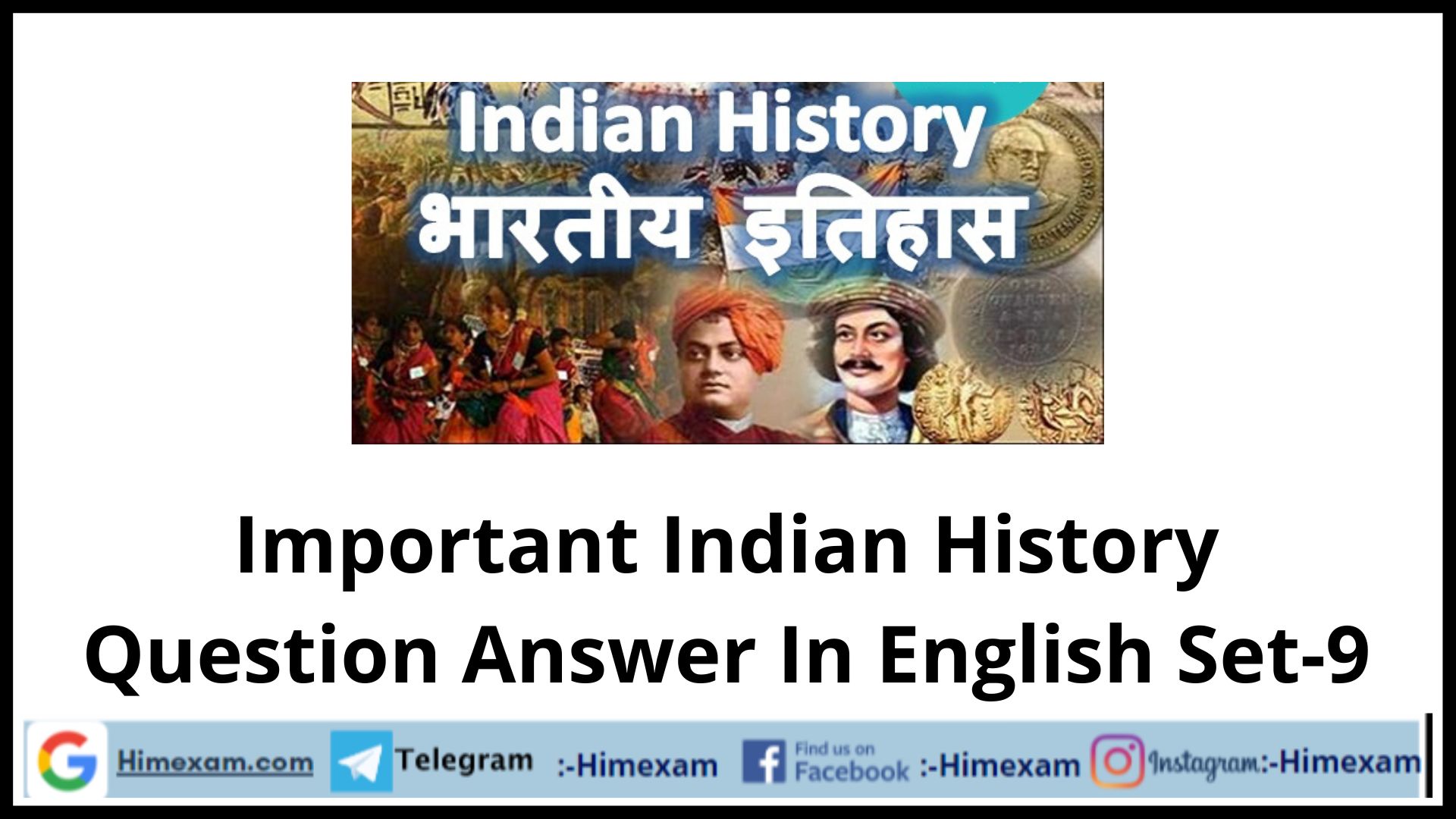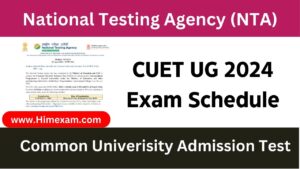Table of Contents
ToggleImportant Indian History Question Answer In English Set-9
||Important Indian History Question Answer In English Set-9||Important Indian History Question Answer for hpssc/hpsssb Set-9||
101. Who started the Saka Era and when ?
(A) Kadphises in 58 BC
(B) Rudradaman I in AD 78
(C) Vikramaditya in 58 BC
(D) Kanishka in AD 78
Explanation:-Most of what is known about Kanishka derives from Chinese sources, particularly Buddhist writings. When Kanishka came to the throne is uncertain. His accession has been estimated as occurring between his reign is believed to have lasted 23 years. The year 78 marks the beginning of the Saka era, a system of dating that Kanishka might have initiated.
102. In which state was the Nalanda University located in India?
(A) Bengal
(B) Bihar
(C) Orissa
(D) Uttar Pradesh
Explanation:-Nalanda was an ancient center of higher learning in Bihar, India. It was a Buddhist center of learning from the fifth or sixth century CE to 1197 CE. Nalanda flourished between the reign of the Chakraditya (whose identity is uncertain and who might have been either Kumara Gupta I or Kumara Gupta II) and 1197 CE, supported by patronage from the Hindu Gupta rulers as well as Buddhist emperors like Harsha and later emperors from the Pala Empire
103. Which event brought about a profound change in Ashoka’s https://himexam.com/wp-content/uploads/2021/12/Madhya-Pradesh-MP-PEB-Group-2-Sub-Group-4-Various-Post-Answer-Key-2021.jpgistrative policy?
(A) The third Buddhist Council
(B) The Kalinga War
(C) His embracing of Buddhism
(D) His sending of missionary to Ceylon
Explanation:-Kalinga War was the only major war Ashoka fought after his accession to throne. It is one of the major and bloodiest battles in the history of India. Kalinga put up a stiff resistance, but they were no match for Ashoka’s brutal strength. The bloodshed of this war is said to have prompted Ashoka to adopt Buddhism.
104. The monk who influenced Ashoka to embrace Buddhism was
(A) Vishnu Gupta
(B) Upagupta
(C) Brahma Gupta
(D) Brihadratha
Explanation:-Upagupta was a Buddhist monk. According to some stories in the Sanskrit Avadana he was the spiritual teacher of Asoka the great Mauryan emperor. Upagupta’s teacher was Sanavasi who was a disciple of Ananda, the Buddha’s attendant. Due to the absence of his name in Theravada literature it is assumed that Upagupta was a Sarvadin monk.
105. Harshvardhana was defeated by
(A) Prabhakaravardhana
(B) Pulakesin II
(C) Narasimhasvarma Pallava
(D) Sasanka
Explanation:-In 630 BC, Harshavardhana faced defeat at the hands of Pulakesin II, the Chalukya King of Vatapi, in Northern Karnataka. The defeat resulted in a truce between the two kings, with Harsha accepting River Narmada as the southern boundary for his kingdom.
106. Which of the following statements about the Guptas is NOT true ?
(A) They ruled mainly over parts of north and central India
(B) Kingship was hereditary and the throne always went to the eldest son
(C) The judicial system was far more developed than in earlier times
(D) Land taxes increased and taxes on trade and commerce decreased
Explanation:-Kingship was hereditary. Though succession to the throne was generally decided by law of primogeniture, that is, the eldest son succeeding his father, there were many exceptions to this rule. Sometimes kings were even elected by nobles and councillors. As head of the government, the King was overseer of all https://himexam.com/wp-content/uploads/2021/12/Madhya-Pradesh-MP-PEB-Group-2-Sub-Group-4-Various-Post-Answer-Key-2021.jpgistrative activities of his realm. He was the supreme judge, and he usually led his army to the battlefields
107. Which of the following was NOT composed by Harshavadhana?
(A) Harshacharita
(B) Ratnavali
(C) Priyadarshika
(D) Nagananda
Explanation:-The Harshacharita, is the biography of Indian Emperor Harsha by Banabhatta, also known as Bana, who was a Sanskrit writer of 7th century in India. He was the ‘Asthana Kavi’, meaning ‘Court Poet’, of King Harsha
108. Which of the following is not one of the animals carved on the Sarnath Pillar ?
(A) Humped Bull
(B)Deer
(C) Elephant
(D) Horse
Explanation:-Ashoka built the Sarnath pillar to commemorate the site of the first preaching of Lord Buddha, where he taught the Dharma to five monks. The Lion Capital of Ashoka comprises four lions, standing back to back, mounted on a cylindrical abacus. The abacus features the sculptures of an elephant, a galloping horse, a bull, and a lion, separated by intervening 24-spoked Dharma wheels over a bell-shaped lotus. The four animals in the Sarnath capital are believed to symbolize different phases in Lord Buddha’s life. The Elephant is a representation of Queen Maya’s conception of Buddha when she saw a white elephant entering her womb in dream. The Bull represents desire during the life of the Buddha as a prince. The Horse symbolizes Buddha’s departure from palatial life while the Lion represents the attainment of Nirvana by Lord Buddha
109. The ‘Kannauj assembly’ organised by Harsha was held in honour of
(A) Fa-Hien
(B) Itsing
(C) Hieun-Tsang
(D) Megasthenes
Explanation:-The convocation of an assembly at Kannauj was one of the most significant events of the reign of Harsha. The purpose of this assembly was to simplify the doctrines of Mahayanism. This assembly was convened in 643 A.D. It was attended by kings of eighteen countries, 3000 Brahmanas and Jains, 3000 Buddhist monks of Mahayana and Hinayana sects and 1000 Buddhist monks of Nalanda Vihara. The famous Chinese traveler, Hiuen Tsang was also present and presided the assembly.
110. The first metal used by man was
(A) Aluminium
(B) Copper
(C) Iron
(D) Silver
Explanation:-The first two metals to be used widely were gold and copper. The use of copper in antiquity is of more significance than gold as the first tools, implements and weapons were made from copper. From 4,000 to 6,000 BC was the Chalcolithic period which was when copper came into common use. By 3600 BC the first copper smelted artifacts were found in the Nile valley and copper rings, bracelets, chisels were found. By 3000 BC weapons, tools etc. were widely found. Tools and weapons of utilitarian value were now within society, however, only kings and royalty had such tools; it would take another 500 years before they reached the peasants.
111. Satvahanas minted their coins predominantly in
(A) Lead
(B) Silver
(C) Gold
(D) Copper
Explanation:-The Satavahana kings mostly used lead as the material for their coins. Most of their coins are in that metal. Silver coins are very rare. Next to lead they used an alloy of silver and copper, called “potin”. Many copper coins are also available. Although the Satavahana coins are devoid of any beauty or artistic merit, they constitute a valuable source-material for the dynastic history of the Satavahanas
112. The headquarters of the Ghadar Party was at
(A) Karachi
(B) Moscow
(C) Berlin
(D) San Francisco
Explanation:-The Ghadar Party, initially the Pacific Coast Hindustan Association, was formed in 1913 in the United States under the leadership of Har Dayal, with Sohan Singh Bhakna as its president. The members of the party were Indian immigrants, largely from Punjab. Many of its members were students at University of California at Berkeley including Dayal, Tarak Nath Das, Maulavi Barkatullah, Kartar Singh Sarabha and V.G. Pingle. The party quickly gained support from Indian expatriates, especially in the United States, Canada and Asia. The party was built around the weekly paper The Ghadar, which carried the caption on the masthead: Angrezi Raj Ka Dushman (an enemy of the British rule). The first issue of The Ghadar was published from San Francisco on November 1, 1913.
113. Where did Lord Budha breathe his last ?
(A) Bodh Gaye
(B) Sarnath
(C) Kushinagar
(D) Varanasi
Explanation:-At the time of the Buddha, Kushinagar was the capital of the Mallas, and the scene of the Buddha’s death. The Buddha died of old age, when he was eighty years old. The death was triggered by his body reaction to a dish of wild mushroom.
114. Fa-hien visited India during the reign of
(A) Chandragupta II
(B) Samudragupta
(C) Ramagupta
(D) Kumaragupta
Explanation:-Chandra Gupta II was the third, and most significant of the Gupta kings. During his reign the famous Chinese pilgrim Fa-Hsien visited India and wrote a detailed account of his kingdom. The celebrated Chinese pilgrim was struck with admiration by the famous royal palace and the houses for dispensing charity and medicine at Pataliputra. He speaks highly of the system of government in the Madhya-desa and the benevolence of the people, especially the moneyed classes.
115. Mention the place where Buddha attained enlighten-ment.
(A) Sarnath
(B) Bodh Gaya
(C) Kapilavastu
(D)Rajgriha
Explanation:-Bodh Gaya is a religious site and place of pilgrimage associated with the Mahabodhi Temple Complex in Gaya district in the Indian state of Bihar. It is famous for being the place where Gautama Buddha is said to have obtained Enlightenment (Bodhimandala). According to Buddhist traditions, circa 500 BC Prince Gautama Siddhartha, wandering as an ascetic, reached the sylvan banks of Falgu River, near the city of Gaya. There he sat in meditation under a bodhi tree (Ficus religiosa). After three days and three nights of meditation, Siddharta claimed to have attained enlightenment and insight, and the answers that he had sought
116. The Greek ambassador sent to Chandragupta Maurya’s Court was :
(A) Kautilya
(B) Seleucus Nicator
(C) Megasthenes
(D) Justin
Explanation:-Megasthenes was a Greek ethnographer and explorer in the Hellenistic period, author of the work Indica. He was born in Asia Minor (modern day Turkey) and became an ambassador of Seleucus I of the Seleucid dynasty possibly to Chandragupta Maurya in Pataliputra. Megasthenes’ Indica is the first wellknown Western account of India and he is regarded as one of the founders of the study of Indian history in the West. He is also the first foreigner Ambassador to be mentioned in the Indian history.
117. Hiuen Tsang visited India during the reign of
(A) Chandragupta I
(B) Chandragupta II
(C) Harshavardhana
(D) Rudradaman
Explanation:-It was during Harsha’s reign that Hiuen Tsang came to India. He has given a vivid description of the social, economic and religious conditions, under the rule of Harsha spoke highly of the king.
118. Which one of the following was the last Buddhist text produced In India ?
(A) Divya Vandana,
(B) Dohakosa
(C) Vajrachedika
(D) Vamsathapakasini
Explanation:-Vamsathapakasini is among the last Buddhist texts produced in India. It gives us information about the origin of the Mauryas.
119. Arthasastra was written by
(A) Dhanananda
(B) Kautilya
(C) Bimbisara
(D)Pushyamitra
Explanation:-The Arthasastra is an ancient Indian treatise on statecraft, economic policy and military strategy which identifies its author by the names ‘Kautilya’ and ‘Vishnaugupta’, both names that are traditionally identified with Chanakya (c. 350–283 BC), who was a scholar at Takshashila and the teacher and guardian of Emperor Chandragupta Maurya, the founder of Mauryan Empire. Because of its harsh political pragmatism, the Arthasastra has often been compared to Machiavelli’s The Prince
120. Worship of Mother Goddess was associated with
(A) Aryan Civilization
(B) Mediterranean Civilization
(C) Indus Valley Civilization
(D) Later Vedic Civilization
Explanation:-In view of the large number of figurines found in the Indus valley, some scholars believe that the Harappan people worshipped a Mother goddess symbolizing fertility, a common practice among rural Hindus even today.
121. Alexander and Porus fought a battle at
(A) Hydaspes
(B) Jhelum
(C) Panipat
(D) Tarain
Explanation:-The Battle of the Hydaspes River was fought by Alexander the Great in 326 BC against King Porus of the Hindu Paurava kingdom on the banks of the Hydaspes River (Jhelum River) in the Punjab near Bhera in what is now modern-day Pakistan. The battle resulted in a complete Macedonian victory and the annexation of the Punjab, which lay beyond the confines of the defeated Persian Empire, into the Alexandrian Empire. The battle is historically significant for opening up India for Greek political (Seleucid Empire, Indo-Greeks) and cultural influence (Greco-Buddhist art) which was to continue for many centuries.
122. Identify the Buddhist Literature from the following :
(A) Tripitakas
(B) Upanishads
(C) Angas
(D) Aranyakas
Explanation:-Tripitaka is a traditional term used by various Buddhist sects to describe their various canons of scriptures. As the name suggests, a Tripitaka traditionally contains three “baskets” of teachings: a Sutra Pitaka, a Vinaya Pitaka and an Abhidharma Pitaka. Tripitaka is the three main categories of texts that make up the Buddhist canon
123. Seleucus Nicator was defeated by
(A) Asoka
(B) Chandragupta Maurya
(C) Bindu Sara
(D) Brihadratha
Explanation:-Seleucus I Nicator was a leading officer of Alexander the Great’s League of Corinth and one of the Diadochi. In the Wars of the Diadochi that took place after Alexander’s death, Seleucus established the Seleucid dynasty and the Seleucid Empire. He was defeated by the emperor of India, Chandragupta Maurya and accepted a matrimony alliance for 500 elephants after ceding the territories considered as part of India
124. The striking feature of the Indus Valley Civilization was
(A) Urban Civilization
(B) Agrarian Civilization
(C) Mesolithic Civilization
(D) Paleolithic Civilization
Explanation:-The most characteristic feature of the Harappan Civilization was its urbanization. The cities show evidence of an advanced sense of planning and organization. The town was extremely well planned. The street ran straight and at right angles to each other following the grid system. The rectangular town planning was unique to the Harappans and was not known in Mesopotamia or Egypt. The streets were very wide and the houses built of burnt bricks lined both sides of the street. In Egypt and Mesopotamia dried or baked bricks were used.
125. After Alexander’s death the Eastern part of his empire came under
(A) Seleucus Nicator
(B) Menander
(C) Rudradaman
(D) Kanishka
Explanation:-Seleucus I was a leading officer of Alexander the Great’s League of Corinth and one of the Diadochi. In the Wars of the Diadochi that took place after Alexander’s death, Seleucus established the Seleucid dynasty and the Seleucid Empire. His kingdom would be one of the last holdouts of Alexander’s former empire to Roman rule. They were only outlived by the Ptolemaic Kingdom in Egypt by roughly 34 years.
126. The early Buddhist scriptures were composed in :
(A) Prakrit texts
(B) Pali texts
(C) Sanskrit texts
(D) Pictographical texts
Explanation:-Pali is the language in which the texts of the Theravada school of Buddhism are preserved. The Pali texts are the oldest collection of Buddhist scriptures preserved in the language in which they were written down.
127. In Mohanjadaro, the largest building is :
(A) the great bath
(B) a granary
(C) the Pillared Hall
(D) a two storeyed house
Explanation:-The Great Granary of Harappa was the largest building of the Indus Valley Civilization. It was about 45 meters long and 15 meters wide. It was meant to store food grains. It had lines of circular brick platforms for pounding grain. There were barrack like quarters for workmen. The granary also had smaller halls and corridors. It was used to store surplus food grains. There were two rows of granaries. Each row had six granaries. A similar granary has been found in Mohanjodaro. All the granaries were built close to the river bank so that grains could be easily transported with the help of boats.
128. The caste system of India was created for :
(A) immobility of labour
(B) recognition of the dignity of labour
(C) economic uplift
(D) occupational division of labour
Explanation:-The caste system is a system of division of labour and power in human society. It is a system of social stratification, and a basis for affirmative action. Historically, it defined communities into thousands of endogamous hereditary groups called Jatis. The Jatis were grouped by the Brahmanical texts under the four well-known caste categories (the varnas): viz Brahmins, Kshatriyas, Vaishyas, and Shudras
129. Gautama Buddha was born at
(A) Kusinagar
(B) Sarnath
(C) Bodh Gaya
(D) Lumbini
Explanation:-Lumbini is a Buddhist pilgrimage site in the Rupandehi district of Nepal. It is the place where Queen Mayadevi gave birth to Siddhartha Gautama, who as the Buddha Gautama founded the Buddhist tradition. The Buddha lived between roughly 563 and 483 BC.
130. Who was the mother of Mahavira?
(A) Yasoda
(B) Anojja
(C) Trishala
(D) Devanandi
Explanation:-Trishala was the Mother of Mahavira, the 24th Tirthankara of Jainism, and wife of the Jain monarch, Siddartha of Kundgraam. She finds mention in the classical Jain Agamas, the Kalpa sutra, written by Acharya Bhadrabahu (433 – 357 BC), which is primarily a biography of the Tirthankaras.
Join Our Telegram Group :- Himexam





